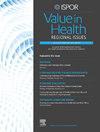Utility Values of Health Status in Gastric Cancer: A Systematic Review
IF 1.4
Q3 HEALTH CARE SCIENCES & SERVICES
引用次数: 0
Abstract
Objectives
Gastric cancer (GC) imposes a significant burden of disease globally. Multiple treatments are available but are associated with high costs and potentially detrimental effects on quality of life. The utility values of health status are measures of patient preference over quality of life, which are increasingly used for health and economic decision-making. Currently, there is little systematized information on the utility values for different stages of GC. This systematic review synthesizes and meta-analyses the literature on GC utilities.
Methods
A search was conducted in PubMed, Embase, MEDLINE, and Cochrane Library for studies reporting utility values calculated using direct and indirect methods. Information from the selected studies was extracted and appraised, and meta-analyses of utility values based on GC health states were performed.
Results
Twelve studies involving 4585 patients were included. Random-effects meta-analysis estimates showed a mean utility of 0.77 (95% CI 0.7–0.85) for stage I, 0.75 (95% CI 0.65–0.85) for stage II, 0.70 (95% CI 0.63–0.96) for stage III, and 0.64 (95% CI 0.56–0.32) for stage IV. All estimates showed considerable heterogeneity.
Conclusions
Our study provides an updated overview of the literature on utility values in GC and presents a discussion of the relevance of GC stages for its analysis. Decision-makers should consider patients’ preferences in the proposal of policies and clinical decisions.
健康状况在胃癌中的效用价值:系统综述。
目的:胃癌(GC)在全球范围内造成了重大的疾病负担。有多种治疗方法,但费用高,对生活质量有潜在的不利影响。健康状况的效用值是衡量患者对生活质量的偏好,越来越多地用于健康和经济决策。目前,很少有关于GC不同阶段的效用值的系统化信息。这篇系统综述综合并荟萃分析了有关GC效用的文献。方法:检索PubMed、Embase、MEDLINE和Cochrane图书馆中报告使用直接和间接方法计算效用值的研究。从选定的研究中提取和评估信息,并对基于GC健康状态的效用值进行荟萃分析。结果:纳入12项研究,共4585例患者。随机效应荟萃分析估计显示,第一阶段的平均效用为0.77 (95% CI 0.7-0.85),第二阶段为0.75 (95% CI 0.65-0.85),第三阶段为0.70 (95% CI 0.63-0.96),第四阶段为0.64 (95% CI 0.56-0.32)。所有估计均显示出相当大的异质性。结论:我们的研究提供了关于GC效用值的最新文献综述,并提出了GC阶段相关性分析的讨论。决策者在制定政策和临床决策时应考虑患者的偏好。
本文章由计算机程序翻译,如有差异,请以英文原文为准。
求助全文
约1分钟内获得全文
求助全文
来源期刊

Value in health regional issues
Pharmacology, Toxicology and Pharmaceutics-Pharmacology, Toxicology and Pharmaceutics (miscellaneous)
CiteScore
2.60
自引率
5.00%
发文量
127
 求助内容:
求助内容: 应助结果提醒方式:
应助结果提醒方式:


